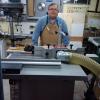Canada went metric in the seventies, so science for me is metric, as is road speed, fuel volumes etc.
In woodworking however I was using Imperial and metric, then I decided to learn the 32mm system for cabinet making. That's when I realised how convenient it was to use metric and not have fractions.
This was very obvious when designing stuff, and I then decided to go metric for all my wood working.
Who can tell if a rail is 3/4" or 19mm or even better, stop converting and make your rails a nice round 20mm........Same for legs, instead of 2 inch use 50mm......On and on.
When I bought my new planer I had to specify mm or inch gauge so I went metric...............And as for whether plywood is metric or imperial, it's neither.
It actually is metric in thickness in North America (has been for a long time as the Plywood Manufacturers in NA went metric), however it's plywood so it's 19mm plus or minus whatever. Doesn't matter what you measure for a dado, it will need shims and different sheets are actually different.
So, make me a metric enthusiast...............Rod.





 Reply With Quote
Reply With Quote





